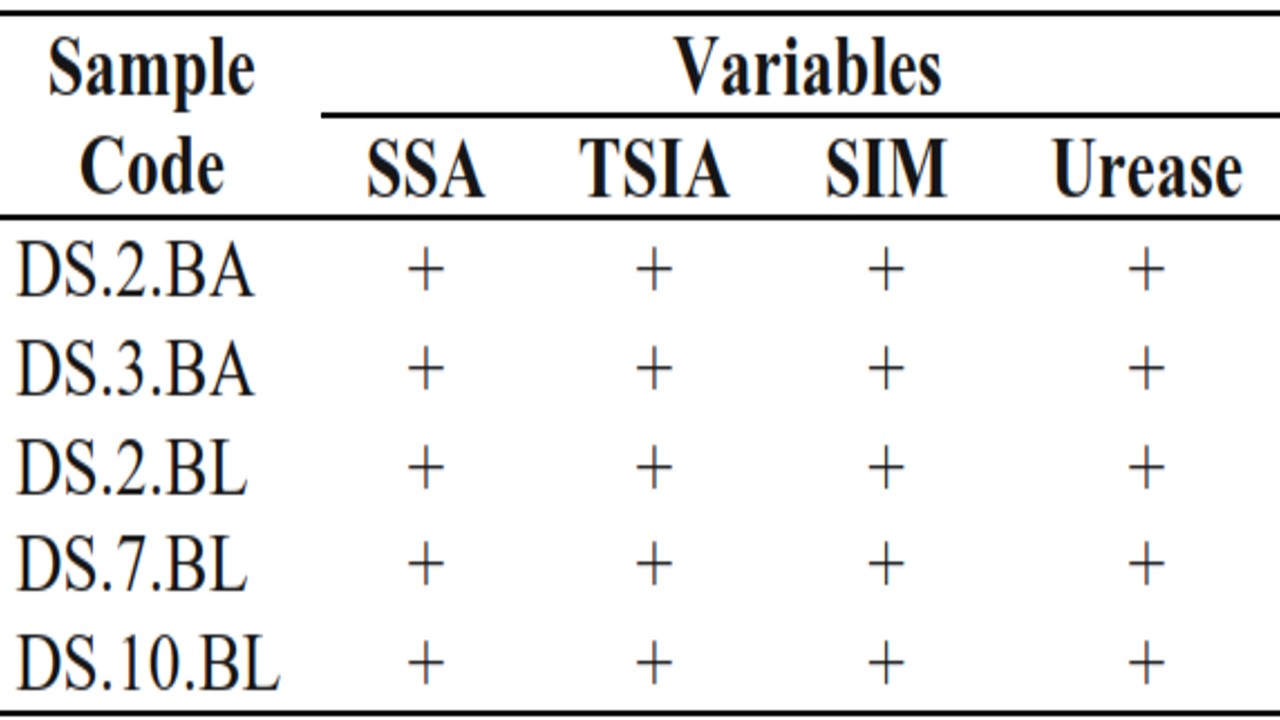Detection of Contamination Salmonella sp. of Beef in Banyuwangi Traditional Market

Downloads
Salmonella sp. is one of the bacteria from Food-Borne Disease agents, can contaminate meat and cause salmonellosis. According to National Indonesian Standard 2009, meat is safe for consumption if it has a negative result of salmonella in 25 grams of meat. The purpose of this study was to determine whether there was contamination of Salmonella sp. on beef sold in the traditional market of Banyuwangi District. A total of 18 samples used in this study were taken according to the criteria for isolation and identification. All samples were enriched with the pre-enrichment stage using Lactose Broth media, and the enrichment medium using Tetrathionate Broth. Furthermore, in the isolation stage using Salmonella Shigella Agar (SSA) media. Then proceed with the identification stage using the Triple Sugar Iron Agar (TSIA) test, the Sulfide Indole Motility (SIM) test, and the Urease test. The results showed that 5 out of 18 samples tested positive for Salmonella.
Arifah, I. N. (2010). Microbiology analysis on food. Study of farm produces technology, Faculty of Agriculture, Universitas Sebelas Maret, Surakarta.
Arnia, & Efrida, W. (2013). Identifying the Contamination of Coliform Bacteria on Fresh Beef sold in Traditional Markets in Bandar Lampung. Jurnal Majority, 2(5).
Bureau of Planning and Development of Banyuwangi District. (2013). Banyuwangi District.
Hajrawati, H., Fadliah, M., Wahyuni, W., & Arief, I. I. (2016). Physical, microbiological, and organoleptic qualities of broiler meat in traditional markets in Bogor. Jurnal Ilmu Produksi dan Teknologi Hasil Peternakan, 4(3), 386-389.
Harsojo, & Darsono. (2016). Study of Heavy Metal Contaminant using Neutron Activation Analysis and Pathogenic Microbes in Beef and Organs. Jurnal Ilmiah Aplikasi Isotop dan Radiasi, 9(2), 129-137.
Hasanah, U., Teuku, R. F., Mahdi, A., Erina, N., & Cut, D. I. (2021). Detection of Salmonella Sp. in Meat Vendors' Hands and Prediction of Its Cause in Peunayong Traditional Market, Banda Aceh. Jurnal Ilmiah Mahasiswa Veteriner, 5(2), 100-107.
Husna, H., Nurlian, N., & Wiqayatun, K. (2020). Identification of Salmonella, Shigella, and E. Coli in the Processed-Meat Produce Sie Balu. Jurnal Public Health, 3(2), 88-94.
Indonesia National Standards (SNI) 2897-2008. Indonesia's Standards for Testing Methods and Contaminant Testing in Meat, Eggs, and Milk and Their Produces.
Indonesia National Standards (SNI) 7388-2009. Indonesia's Standards for Maximum Limit of Microbe Contamination in Food.
Indriyani, D. P., Wiwiek., T., & Ratih., N. P. (2019). Isolation and Identification of Salmonella in Beefs in Banyuwangi Butcher House. Jurnal Medik Veteriner, 2(2), 83-88.
Ministry of Agriculture. (1992). Decree No: 413/Kpts/TN.310 /7/1992, about Farm Animal Butchering and Handling of Meat and Its Other Produces. Jakarta
Moekti, B. S., Nabila, A. H., Mega, U. E. M., & Lailia, D. K. W. (2020). Prevention of Salmonellosis Disease Through Animated Educational Song Video for Elementary, Junior, and High School Students in Surabaya. Jurnal Pengabdian Pada Masyarakat, 2(1).
Momani, W. A., Janakat, S., & Khatatbeh, M. (2018). Bacterial Contamination of Table Eggs Sold In Jordania Markets. Pakistan Journal of Nutrition, 17(1), 15-20.
Mukhtaruddin, Fakhrurrazi, & Mahdi. A. (2018). Isolation and Identification of Salmonella Sp in Chicken's Intestines in Lampuja Village, Aceh Besar. Jurnal Ilmiah Mahasiswa Veteriner, 3(1), 24-36.
Pratiwi, F. S., Padaga, M. C., & Wuragil, D. K. (2014). Isolation and characterization of Salmonella Sp in the carcass and viscera of chicken sellers in Malang. Jurnal Medika Veteriner, 3(2).
Ramadhanii, D., Fakhrurazzi, & Mahdi, A. (2017). Isolasi dan Identifikasi Bakteri Salmonella Enteritidis Pada Daging Sapi Yang Dijual Di Pasar Tradisional Kota Banda Aceh. Jurnal Ilmiah Mahasiswa Veteriner, 1(4), 625-630.
Ratnawati, Nurliana, & Razal. (2014). Consumer Satisfaction Rate towards Quality and Price of Beef Sold in Banda Aceh. Agripet, 14(2), 125-131.
Rohmah, Mohammad, F. F. M., & Umi, P. (2018). Physical Analysis of Beef Affected by Concentrate and Soaking Duration of Kenikir (Cosmos caudatus kunth). Agrointek, 12(1), 51-54.
Sa'idah, F., Yusnita, S., & Herlinawati, I. (2011). Research results of microbe contamination in beef sold in the modern and traditional market. Dilavet, 21(2), 1-4.
Sangadji, I., Jurianto, & Muhammad, R. (2019). The Impact of Broiler Meat Storage Duration to Its Quality As Perceived from Its Protein and Total Bacteria. BIOSEL (Biology Science and Education): Jurnal Penelitian Science dan Pendidikan, 8(1), 47-58.
Sarassati, T., & Kadek, K. A. (2015). Quality of Wagyu Beef and Balinese Beef Stored at -19oC. Indonesia Medicus Veterinus, 4(3), 178-185.
Sartika, D., Susilawati, & Gusman, A. (2016). Identifying Salmonella Sp. Contamination in Broiler Chicken by Quantifying Methods from Three Traditional and Two Modern Markets in Bandar Lampung. Jurnal Teknologi & Industri Hasil Pertanian, 21(2), 89-96.
Statistics Indonesia (BPS) Banyuwangi District. (2019). Banyuwangi District in Numbers.
Sugiyoto, Kusuma, A., & Veronica, W. (2015). Kandungan Mikroba pada Daging Sapi dari Beberapa Pasar Tradisional di Bandar Lampung. Jurnal Ilmu Peternakan Terpadu, 3(2), 27-30.
Sukmawati, S. (2018). Total Microbial Plates on Beef and Beef Offal. Bioscience, 2(1), 22-28.
Susanto, E. (2014). Standard Post-Harvest Handling of Fresh Meat. Jurnal Ternak, 5(1).
Suwito, W. (2011). Distribution of Salmonella serotype From Slaughterhouse (RPH) And Chicken Abattoir (TPA) In Bogor. Widyariset, 14(2), 361-366.
Wahyuningsih, E., Indah, S., & Musyarif, Z. (2019). Identifying Salmonella sp. In Chicken Eggs Sold in Wage Traditional Market Purwokerto as a Microbiology Teaching Material Development. Bioedusiana: Jurnal Pendidikan Biologi, 4(2), 79-83.
Zahrarianti, R., Kusmajadi, S., & Lilis, S. (2012). Effects of Soaking in Various Concentrate of Rosella Petal Extract (Hibiscus Sabdariffa Linn) to the Total Bacteria, Shelf Life, and Beef Color. Students e-Journal, 1(1), 15.
Copyright (c) 2022 Muril Hizriyana Hanifa

This work is licensed under a Creative Commons Attribution-NonCommercial-ShareAlike 4.0 International License.
Authors who publish in this journal agree to the following terms:
1. The journal allows the author to hold the copyright of the article without restrictions;
2. The journal allows the author(s) to retain publishing rights without restrictions;
3. The legal formal aspect of journal publication accessibility refers to Creative Commons Attribution-NonCommercial-ShareAlike 4.0 International License (CC BY-NC-SA).






11.jpg)




















